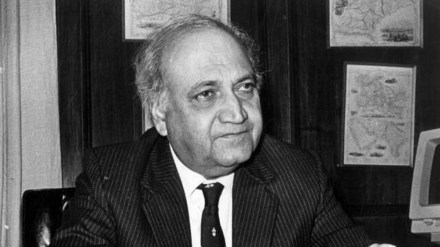Brazil’s loss was quite clearly India’s gain. After graduating from Wharton University, a young Keshub Mahindra told his father JC that he would be leaving for Brazil as he had got an interesting job offer. The senior Mahindra congratulated his son but asked him to come to India for a few days as he hadn’t been home for six years.
In a 1996 interview to Knowledge at Wharton, Keshub Mahindra said he readily agreed as he had no idea about his father’s secret plan of roping him into Mahindra & Mohammed, a company JC Mahindra had co-founded in 1945. A visit to the company’s plant impressed the 22-year-old so much that he decided to skip the flight to Brazil. The company had a technical and financial collaboration with Willys Overland Corporation to assemble Jeep-type vehicles in the 1950s.When Pakistan was formed, the Mohammeds divested their stake, which led to the renaming of the company to Mahindra & Mahindra (M&M) in 1948. Keshub Mahindra joined the board soon after.
Also read: Video: Indian MSME exports have a lot of competition currently, says PHD Chamber’s Vipin Vohra
That association with M&M lasted till he passed away at his home in south Mumbai on Wednesday at age 99. He was chairman for 49 years till he relinquished the position in 2012 and handed over the reins to his nephew Anand Mahindra. He became Chairman Emeritus after that.
His sterling work at M&M didn’t go unnoticed. When he was M&M chairman, the government had offered him a Cabinet minister’s position, which he declined. Though he regretted that decision later in life as he said his “personal interests always lay in upholding the dignity of individuals and supporting their growth”, M&M employees over the years would be happy that he declined the offer.
Old-timers at M&M fondly recall when at the 50th anniversary of the group, 10,000 employees put their chairman and his wife in an open Jeep and threw rose petals on them. And this in a year when the company went in for reduction in the number of employees because of competitive pressures. The entire process was done in a humane manner: workers were first explained the reasons for the layoff decision and were offered full pay even if they stayed at home till the company could find them alternative job opportunities.
The KC Mahindra Trust under his stewardship has been focusing heavily on inclusive growth and educating girls by setting up vocational schools and providing scholarships to the needy. The Mahindra group has also established the United World College in Pune. A lot of his philanthropic work, however, went largely unnoticed as he always preferred to shun the limelight.
That he stood for principle all his life is undisputed, the most famous example being his decision to turn down a Padma Bhushan because the Union Carbide gas leak trial was still going on. He was the non-executive chairman of Union Carbide India in 1984 when one of the world’s biggest industrial disasters happened. But subsequent court hearings were still not over.
During his chairmanship, the Mahindra Group grew from a manufacturer of automobiles to a federation of companies operating in a range of businesses including automobiles, tractors, auto components, real estate, financial services and hospitality.
When liberalisation happened in 1991, Keshub Mahindra wasn’t too happy with the speed at which the market was opened up to foreign players and was part of the so-called Bombay Club which demanded a level playing field. But he sensed soon enough that the process was irreversible and quickly undertook a radical re-engineering of M&M’s shop floor, a restructuring of its corporate core and a refocusing of its strategy around a smaller group of businesses. Deliberate decisions were made to sell off its oil drilling, a highly profitable division, and business machines businesses. The corporate mission really was in the area of vehicle production where he saw M&M can become globally competitive.
Also read: Starting export business? Here’s how step-by-step you can get your export license online
He was also one of the first Indian industrialists to put in place a professionally run structure at a family-owned enterprise. When he relinquished his executive position in 1979, BR Sule took over as managing director.
The Cabinet minister offer notwithstanding, Keshub Mahindra had several run-ins with the government. In 1979, he relinquished his executive position at M&M protesting the government’s plan to cap executive salaries. His reasoning: the government has no business to get into micro-managing business.
His initial opposition to reforms notwithstanding, he also became a strong advocate against the licence-permit raj when the government stopped him from realising a personal passion: a pure made-in-India car. His plans to tie up with Renault in the 1950s and with Peugeot in the 1980s were also thwarted. That ambition was realised much later when Mahindras partnered with Ford.
Such problems, however, didn’t stop the governments from benefitting from his sage advice. He started the Housing and Urban Development Corporation (HUDCO) and ran it for over six years. Besides, he was appointed on many committees, including the Sachar Commission on company law & MRTP, and was a member of the Prime Minister’s Council on Trade & Industry from 2004 to 2010.
Just a few days ago, Mahindra re-entered the Forbes list of billionaires with a net worth of $1.2 billion. In fact, he was ranked India’s oldest billionaire — something he obviously couldn’t care less about. For, the gentle corporate giant never wore his wealth on his sleeve.
